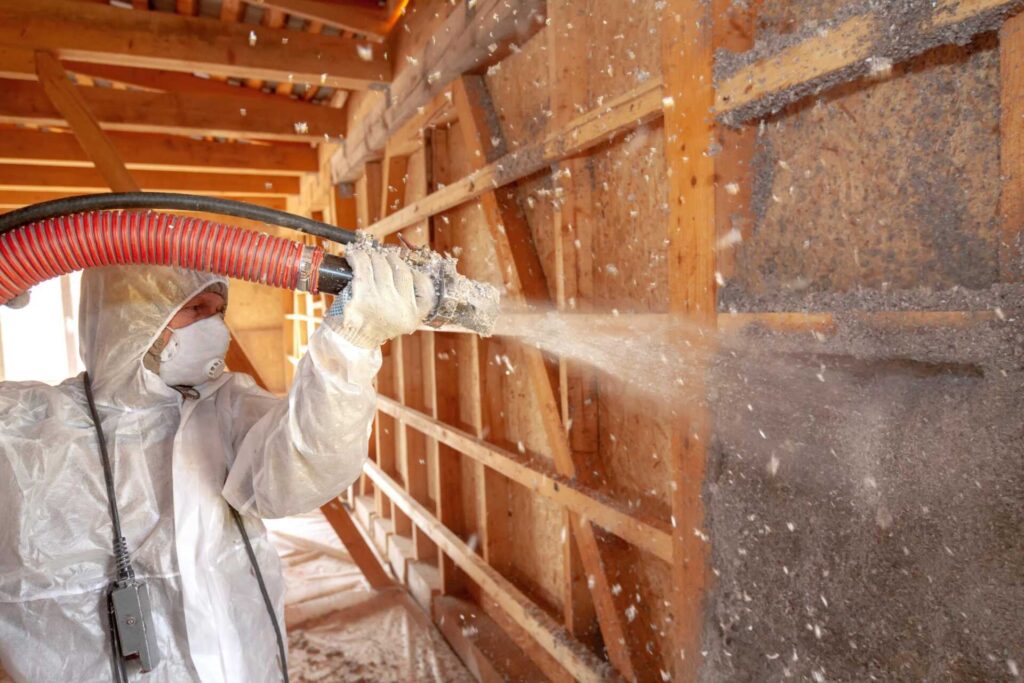
Contents
Navigating the world of professional blow-in attic insulation can feel like wandering through a maze of variables. You might wonder how much you should expect to invest to enhance your home’s energy efficiency and comfort. Costs typically range from $1 to $3 per square foot, but several factors can influence this pricing. It’s crucial to consider elements like material quality and the attic’s current state. So, how do you ensure you’re making the best choice without overspending?
Key Takeaways
- Professional blow-in attic insulation typically costs between $1 to $3 per square foot, including materials and labor.
- For an average attic size of 1,000 sq ft, total installation costs range from $1,000 to $3,000.
- Pricing can vary based on location, insulation material, and complexity of the job.
- High-quality materials like fiberglass offer better R-value and long-term energy savings compared to lower-quality options.
- Obtaining multiple quotes from certified professionals helps ensure competitive pricing and effective insulation installation.
Factors Influencing Insulation Costs
When considering blow-in attic insulation, several factors can significantly influence your overall costs. First, the installation techniques you choose play a crucial role. Professional installers often have access to advanced equipment that ensures even coverage and effective sealing. If you decide to go the DIY route, you might save on labor costs, but you’ll need to invest in the right tools and materials, which can add up quickly.
Next, material quality is another major factor in determining expenses. High-quality insulation materials, such as cellulose or fiberglass, tend to cost more upfront but offer better thermal performance and longevity. Choosing lower-quality options might save you money initially. Still, they may not provide the same level of energy efficiency, leading to higher heating and cooling bills in the long run.
Additionally, consider the R-value of the insulation you’re installing. A higher R-value means better-insulating properties, which can be particularly beneficial in climates with extreme temperatures. While the upfront costs for higher R-value materials might be greater, they can lead to significant long-term savings on energy bills.
Lastly, the size and condition of your attic can also affect costs. Larger spaces require more insulation, and if your attic has existing issues like moisture or pests, remediation might be necessary before you can install new insulation.
Average Pricing for Blow-In Insulation
How much should you expect to pay for blow-in insulation? On average, installation costs range from $1 to $3 per square foot. This pricing typically includes both materials and labor. For an average attic size of about 1,000 square feet, you’re looking at a total cost between $1,000 and $3,000.
However, prices can vary significantly based on factors such as your location, the type of insulation material chosen, and the complexity of the job.
In recent years, insulation pricing trends have shown a gradual increase, mainly due to rising material costs and labor shortages. It’s important to keep an eye on these trends to budget effectively for your insulation project.
For example, cellulose tends to be less expensive than fiberglass, but it may require more installation time, affecting overall costs.
When considering your options, remember that investing in high-quality blow-in insulation can lead to long-term savings on energy bills. While the initial outlay might seem daunting, the return on investment often justifies the expense.
It’s also wise to get multiple quotes from contractors to ensure you’re getting a fair price.
Ultimately, understanding the average installation costs and current pricing trends empowers you to make informed decisions about your insulation needs. You’re not just insulating your attic; you’re enhancing the comfort and efficiency of your home for years to come.
Comparing Insulation Materials
Choosing the right insulation material can significantly impact your attic’s energy efficiency and overall comfort. When comparing insulation options, fiberglass and cellulose are two popular choices, each with distinct pros and cons.
Fiberglass insulation boasts several advantages. It’s non-combustible, resistant to moisture, and typically has a higher R-value per inch than cellulose. This means it can provide better thermal resistance in a thinner layer, making installation easier in tight spaces.
Additionally, fiberglass is widely available and often less expensive upfront, appealing to budget-conscious homeowners.
However, cellulose insulation has its drawbacks. While it’s made from recycled paper, making it an eco-friendly choice, it can absorb moisture over time. This moisture retention can lead to mold growth and reduced effectiveness if not properly managed.
Furthermore, cellulose insulation may settle over time, which can diminish its insulation properties and require reapplication to maintain efficiency.
Ultimately, the choice between fiberglass and cellulose insulation should reflect your specific needs and priorities. If you’re looking for a cost-effective, moisture-resistant solution, fiberglass may be the way to go.
On the other hand, if sustainability and superior air sealing are your top concerns, cellulose could be more appealing. Weighing these fiberglass pros and cellulose cons can help you make an informed decision that aligns with your values and lifestyle.
Potential Energy Savings
Investing in blow-in attic insulation can lead to significant energy savings, often reducing heating and cooling costs. This enhances your home’s energy efficiency and contributes to a more sustainable lifestyle. By ensuring your home maintains a consistent temperature, you’ll find comfort in knowing you’re minimizing energy waste.
To illustrate the potential benefits, consider the following cost reduction projections based on your energy consumption:
| Year | Estimated Savings | Cumulative Savings |
|---|---|---|
| Year 1 | $300 | $300 |
| Year 2 | $350 | $650 |
| Year 3 | $400 | $1,050 |
The table above shows how quickly the savings can add up. With each passing year, your investment in blow-in insulation pays off, allowing you to allocate those funds towards other important aspects of your life, like family activities or home improvements.
Moreover, improved energy efficiency doesn’t just lower bills; it increases your home’s value. Potential buyers are often attracted to homes with a reputation for energy savings, making your property more appealing in the real estate market.
Embracing blow-in attic insulation is not just a practical choice; it’s a step towards belonging to a community that values sustainability and smart living. By making this investment, you’re saving money and contributing to a greener future for everyone.
Choosing the Right Insulation Company
With the potential energy savings from blow-in attic insulation in mind, selecting the right insulation company becomes a key factor in maximizing your investment.
You’ll want to ensure that the company you choose has solid insulation qualifications and a strong company reputation. Here are three essential steps to guide your decision-making process:
- Check Qualifications: Look for companies with certified insulation professionals. They should have the necessary training and experience to handle your specific needs.
Verify that they follow local building codes and industry standards.
- Research Reputation: Spend some time reading reviews and testimonials from previous customers.
A company with a strong reputation will have positive feedback and a history of satisfied clients.
Don’t hesitate to ask for references and reach out to them for insights on their experiences.
- Get Multiple Quotes: Don’t settle for the first estimate you receive.
Obtaining multiple quotes can give you a better understanding of the market rate, allowing you to compare pricing and services.
Pay close attention to the details in each quote, ensuring that they include the same scope of work and materials.
Review
Investing in professional blow-in attic insulation can significantly enhance your home’s energy efficiency and comfort. By understanding the factors that influence costs and comparing different materials, you can make an informed decision. Remember, getting multiple quotes is key to ensuring you’re not throwing your money down the drain. So, take the time to choose the right insulation company and reap the rewards of a well-insulated attic for years to come.
Recent Posts
Top Attic Air Sealing Techniques for Insulation
Have you ever considered how much energy might be wasted through unnoticed gaps in your
Top 10 Attic Air Sealing Techniques for Insulation
Just as a tightly sealed ship avoids leaks and remains buoyant, your attic’s air sealing
What Are the Best Attic Air Sealing Techniques?
When it comes to attic air sealing, understanding the common leakage points is vital for

